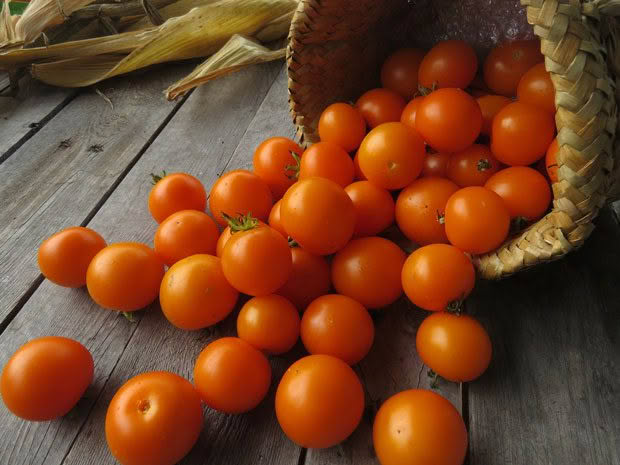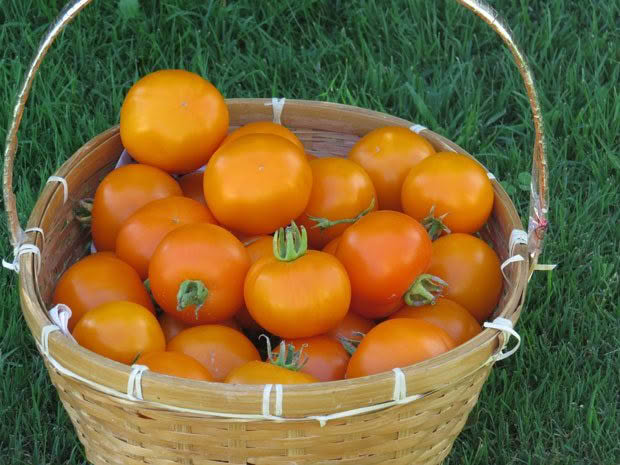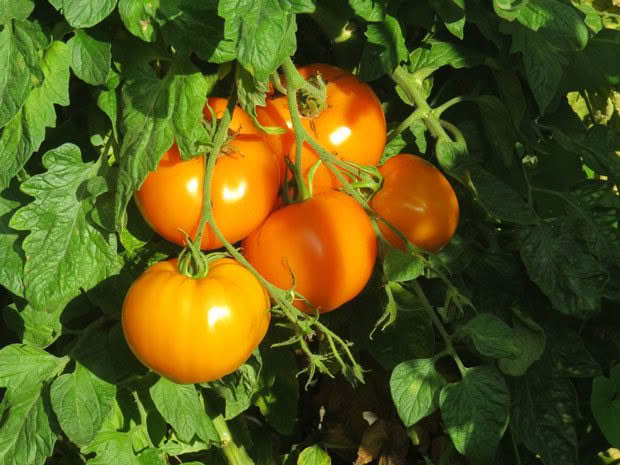We ask the experts: Which tomatoes are the healthiest to grow?

There are hundreds of varieties of tomatoes to try but these ones are the healthiest.
Words Jane Wrigglesworth
A tomato is a tomato is a tomato, except when chemical analysis shows it to contain high levels of the heart-healthy antioxidant tetra-cis-lycopene. Then it becomes an overnight sensation. Tetra-cis-lycopene is a highly bioavailable form of lycopene. Studies have shown that high lycopene intake is associated with decreased risk of heart disease and cancer, especially prostate cancer. But it’s not the red toms that score the highest for tetra-cis-lycopene.
The true gems are the golden-orange ones. “It is our understanding that the first cultivated tomatoes discovered growing in Mexico in the early 1500s, and which were taken to Europe, were golden-orange in colour and would have contained tetracis-lycopene,” says Mark Christensen, Research Director of Heritage Food Crops Research Trust based in Wanganui.
“As crossings occurred to make red tomatoes, the lycopene changed to the all-translycopene form, which is not easily absorbed by the human body.”
All-trans-lycopene is better absorbed the body when it’s cooked. However, tetra-cislycopene has good bioavailability when the tomato is consumed fresh, which is what many people prefer.
But there is one obstacle to better health via tomato. Not all tomatoes with a goldenorange hue contain tetra-cis-lycopene. “This colour can also be expressed by beta-carotene,” says Mark. “It is necessary to chemically analyse each tomato variety to verify whether or not it contains tetracis-lycopene.”
Luckily, Plant & Food Research has done just that. It analysed more than 500 heritage tomatoes provided by Mark, identifying several varieties with high levels of tetra-cis-lycopene*: • Amish Yellowish Orange Oxheart, which had the highest score of 8.21; • Olga’s Round Golden Chicken Egg, score 7.27; • Orange Fleshed Purple Smudge, score 6.99.
*See full table: heritagefoodcrops.org.nz
THE EXPERTS’ CHOICES
We asked Mark Christensen of Heritage Food Crops Research Trust, Kay Baxter of Koanga Institute, and Gerard Martin of Kings Seeds to give us their favourite tomato choices.
HEALTHIEST TOMATO
Olga’s Round Golden Chicken Egg, one of the richest in the most readily-absorbed form of lycopene with a level of 7.27 – it grows better for us than Amish Yellowish Orange Oxheart (which scores highest). It is a good all-round tomato – Mark Christensen of Heritage Food Crops Research Trust.
The overall healthiest depends upon how they are eaten; cooked and then fermented is best – way, way more nutrition (as shown in Koanga’s cook book Body and Soul) – Kay Baxter of Koanga Institute
Orange tomatoes have more readily available lycopene than red ones. Option: Chef’s Choice Orange. – Gerard Martin of Kings Seeds

Olga’s Round Golden Chicken Egg.
BEST FOR NORTH ISLAND
Moonglow, winner of an heirloom tomato tasting competition in the USA, has a tetra-cis-lycopene level of 5.38. –Mark Christensen of Heritage Food Crops Research Trust
Alma for drying, Oxheart for saucing, Watermouth for slicing, cherries for salads and raw. – Kay Baxter of Koanga Institute
Chefs Choice Orange, Black Cherry and Diplom. –Gerard Martin of Kings Seeds

Moonglow.
BEST FOR SOUTH ISLAND
Olga’s Round Golden Chicken Egg, an heirloom from Siberia. Easy to grow, excellent flavour, has a tetracis-lycopene level of 7.27. –Mark Christensen of Heritage Food Crops Research Trust
Scotland Yellow, amazing, reliable; Henry’s Dwarf Bush Cherry, easy to grow; Yellow Pear, great cherry tomato and a South Island heirloom. –Kay Baxter of Koanga Institute
Hybrids to get them a bit earlier: Andiamo, Best Boy Bush and Early Doll. –Gerard Martin of Kings Seeds
![]()
Read more on which tomatoes are best to grow for taste, disease resistance and the most prolific in the September 2018 issue of NZ Lifestyle Block, on sale 27 August, or subscribe here.

Traditionally, tomatoes are planted in the garden on or around Labour Day. Here’s how to get them started for a long and productive season.
Words: Jane Wrigglesworth
◊ If you sow your seeds undercover during September, they should be ready to plant out by October 23, when it’s traditionally deemed that all risk of frost has passed (although that’s not always the case, of course).
◊ If you follow phenology – the study of recurring plant and animal lifecycle changes in relation to the weather – the time to plant your tomatoes, capsicums and peppers is when the daylilies flower, and that usually occurs in October. Daylily buds open in relation to the accumulated warmth of the season, coinciding with the ideal time to plant out your tomatoes.
◊ In any case, the soil needs to be warm. If you plant in cold soil, the foliage can turn purple, which indicates a phosphorus deficiency. When soil is cold, phosphorus becomes unavailable to plants.
Once soil temperatures rise, the problem usually corrects itself.
◊ Planting out too early can also result in ‘cat-facing’. These are misshapen fruit with scars and puckering on the blossom end, caused by incomplete pollination during cold weather, temperature shifts and insect damage.
◊ Before planting, dig in plenty of compost, and position your plants in sun. Allow for plenty of room. The more crowded your plants, the less they will produce and the more prone to disease they’ll be. Space plants at least 40cm apart.
◊ Stake indeterminate varieties at the outset, otherwise you could damage the roots when inserting stakes later on.
◊ Determinate varieties do not need staking, as they are not vining types. They reach a certain height then stop growing, at which stage the tomatoes ripen and the plant dies back. This can be useful if you want early tomatoes, as you can harvest in three months from sowing to maturing. Roma and Scoresby Dwarf are two excellent determinate tomato varieties.
◊ Plant tomatoes deeply. Pinch off the bottom set of leaves on the stem and bury the roots and stem in your prepared garden soil up to the bottom leaves. The plant will form new roots all along the buried stem and this will enable the plant to reach out and absorb more water and nutrients from the soil.
◊ Feed plants every two weeks with a balanced, water-soluble plant food. Once your plants begin to flower, switch to a specialist tomato fertiliser, which is high in potassium, to encourage lots more flowers and fruit. Lay off the high-nitrogen fertiliser at this stage or you’ll encourage plants to produce leaves at the expense of fruit.
◊ Water regularly and consistently or you may experience fruit split, blossom-end rot and other tomato disorders.
READ MORE
Meet the Romano family who have been growing capri tomatoes in Nelson since the 1940s
Meet the Romano family who have been growing capri tomatoes in Nelson since the 1940s
 This article first appeared in NZ Lifestyle Block Magazine.
This article first appeared in NZ Lifestyle Block Magazine.
